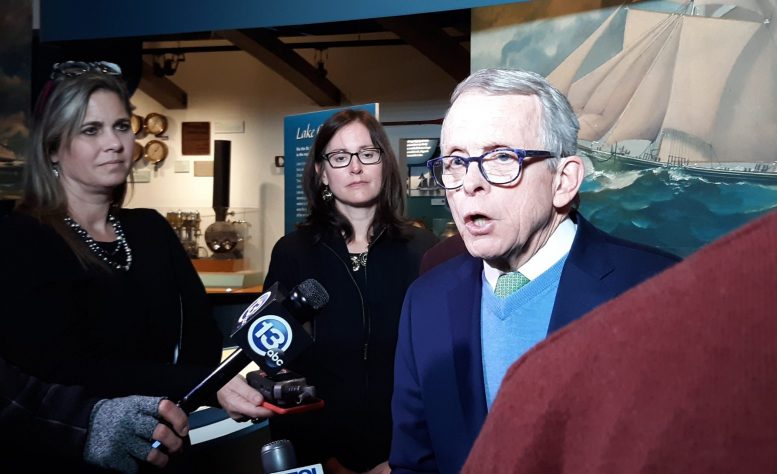After chronic testing shortages marred the first few months of its COVID-19 response, the Ohio Department of Health projects it will double its current testing capacity by November.
ODH plans to complete diagnostic testing of more than 1 million Ohioans per month for the new coronavirus by November and conduct serologic (antibody) testing on another 450,000 per month as well, according to strategy documents submitted to the federal government.
“Serology will serve an important role in reopening the economy and identifying communities that are vulnerable to COVID-19 outbreaks,” the documents state. “In addition, the state continues to closely monitor advances in saliva testing, rapid point-of-care testing, antigen tests and home-based tests.”
The “Overarching Jurisdictional SARS-COV-2 Testing Strategy” documents, provided on request by Gov. Mike DeWine’s office, were submitted to the U.S. Department of Health and Human Services as a requirement attached to a congressional COVID-19 relief package.
In the past, DeWine has made lofty promises about testing expansions that have failed to come to fruition.
At a televised press briefing in April, he said Ohio would have “testing capacity” by the end of May to process 22,000 tests per day. Between July 1 and Tuesday, Ohio has tested an average of about 18,000 people per day.
“That seems far off from the 22,000 tests per day Governor DeWine anticipated for the end of May,” said Daniel Tisch in June, who serves as director of the masters in public health program at Case Western Reserve University.
Testing is a critical piece of any state’s pandemic response — it’s how officials can identify the sick (who may be asymptomatic) and isolate them from the healthy.
A positive test triggers a process by which contact tracers can determine who else may have been exposed to the virus and prevent those people from enabling an outbreak to snowball.
As capacity stands today, Ohio, like 33 other states, is not conducting enough COVID-19 testing to mitigate the spread of the virus, according to research from the Harvard Global Health Institute published with The New York Times.
The Harvard research, based on methodology that’s updated as infection rates change, indicates Ohio is processing about 71% of the testing required for officials to adequately see and control the outbreak.
Adjusting for population, Ohio exceeds just 10 states in terms of COVID-19 testing, according to data from Johns Hopkins University.
Meanwhile, new cases are emerging at a record pace. Of the ten heaviest new caseloads in a day, eight of them were in July (the other two followed the mass testing of state prisons in April).
The rate at which tests are returning with positive results has increased as well this month,inching past 6%.
To scale up testing as planned, ODH will hire new staff, purchase lab equipment, and procure millions of swabs, media, and reagents. The document does not spell out how ODH plans to go about the procurement or how much it will cost.
The infrastructure expansions will be necessary to meet an increased demand, fragile supply chain and “the expected resurgence of COVID-19 corresponding to the traditional flu season.”
Melanie Amato, an ODH spokeswoman, said in an emailed statement that Ohio has “significantly” expanded testing, raising its seven-day average from about 9,000 in May to more than 20,000 today.
She said there’s much to be learned about what serology test results mean but there’s consensus it will become more and more prevalent, especially as more research is available. The CDC says it’s not yet known whether people with antibodies can become reinfected.
In terms of research, ODH is working with the Ohio State University to test about 1,200 randomly sampled Ohio adults for current (via diagnostic testing) and past (antibody) infection with the coronavirus.
“The results will be representative of the state and will help Ohio’s leaders make informed decisions about the physical health and economic well-being of Ohioans,” Amato said.
“Governor DeWine has and will continue to advocate for expanded testing, and we believe the state’s plan positions us to help implement the measures necessary to control community spread and protect Ohioans from the pandemic.”
***
I was exposed to COVID-19 and couldn’t get tested for 16 days
Saturday morning was filled with sorrowful tears as I sat in my stuffy, three-bedroom apartment pleading with a doctor to refer me for a test.
After the video call — which lasted all of 10 minutes — two weeks of anger, frustration and confusion rushed over me.
On July 1, I was notified by a friend, and later the state health department, that I came into contact with someone who tested positive for COVID-19. Within two hours, I zoomed down U.S. Route 33 toward Athens, Ohio and away from my parents’ house in downtown Columbus. A two-week stock of groceries in tow, I was going to carry out my mandated quarantine in my dormant college apartment. READ MORE
More Medicaid funding needed to survive the recession, advocates say
After cuts to the state’s health care assistance program, Medicaid advocates are hoping a temporary federal funding increase will continue.
In May, Ohio Gov. Mike DeWine announced cuts to many state agencies, but the biggest cuts hit Medicaid and education. The budget for Medicaid was chopped by $210 million.
Much of that original cut represented savings from a lack of service due to stay-at-home orders this spring. Whether those savings can continue remains to be seen as health care services reopen.
The think tank Policy Matters, and other Medicaid advocates partnered with medical professionals on Tuesday to discuss reasons Ohio’s U.S. Senators should support funding for the program in a proposed federal stimulus bill, also known as the HEROES Act.
Participants in a virtual call said the state will need increased Medicaid funds to account for a recession that will last longer than the pandemic. READ MORE





